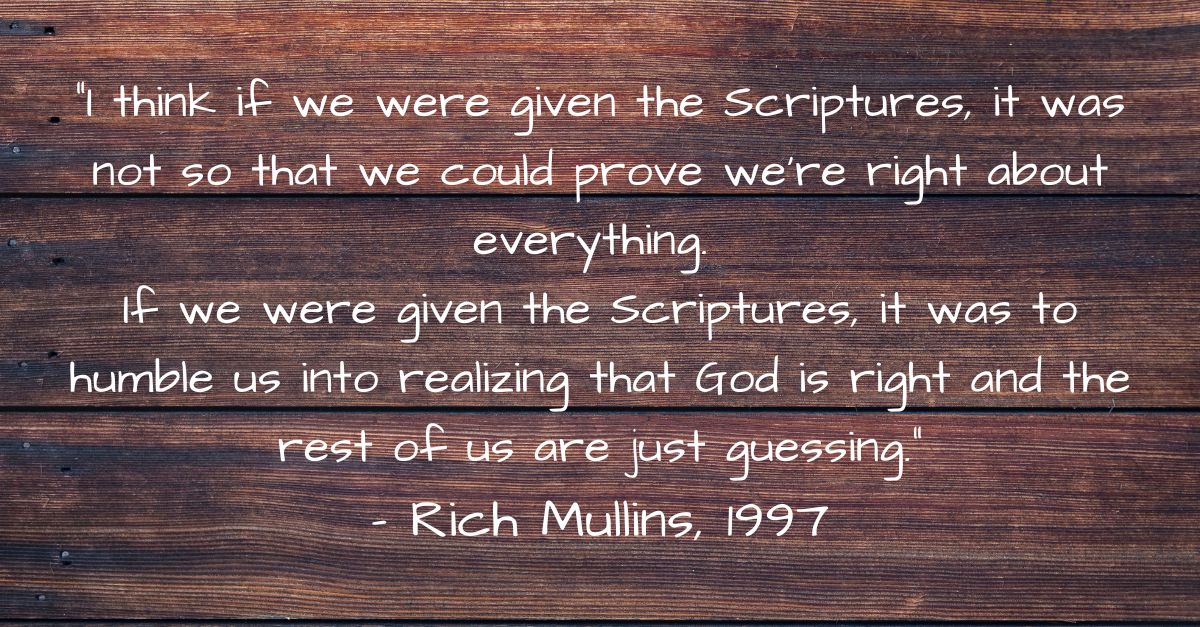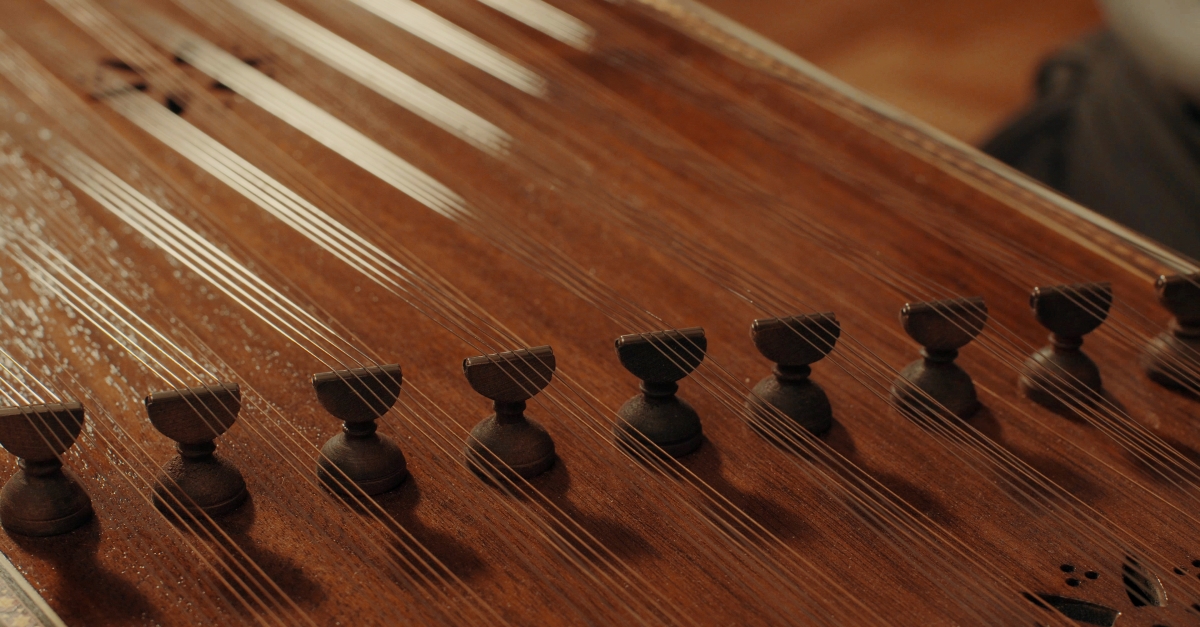Richard Wayne Mullins (1955-1997) was one of the most important, and also one of the most complex, figures in Contemporary Christian Music. He wrote many classic songs, from “Awesome God” to “Sometimes by Step.” On the other hand, his friend Amy Grant called him “the uneasy conscience of Christian music.” He would talk onstage about his chosen industry being more business than ministry, or remind audiences that Jesus called Christians to be more than just nice people living in the suburbs. He also frankly admitted his struggles, from alcoholism to pride.
To some extent, Mullins was to Christian music what Johnny Cash was to country music: his life had great highs and great lows, but his willingness to admit his mistakes gained people’s respect. Long after blander musicians have come and gone, his craft and honesty have survived.
Here is what you should know about the life, and legacy of Rich Mullins.
10 Important Events in the Life of Rich Mullins
1. On October 21, 1955, Rich Mullins was born in Richmond, Indiana, to Neva and John Mullins.
2. In 1974, Mullins began attending Cincinnati Bible College. During his college years (1974-1978), he gave some of his first performances, started the short-lived Rich Mullins Band, and began a long-term romantic relationship.
3. In 1978, Mullins finished college and began working at Zion Ministries in Ohio. He played with the ministries’ worship band, which evolved into the band Zion.
4. In 1981, Amy Grant recorded Mullins’ song “Sing Your Praise to the Lord,” and Zion recorded its only album, Behold the Man.
5. In 1982, Zion split up, letting Mullins move to Tennessee for his solo career. At some point during this year (1982-1983), Mullins' engagement to his girlfriend ended and he wrote “Doubly Good to Me” as a worship song amid difficult times.
6. In 1986, Mullins released his first solo album, Rich Mullins, and appeared as a supporting act in Amy Grant’s Unguarded act.
6. In 1988, disenchanted with the music industry, Mullins moved from Tennessee to Wichita, Kansas. He spent the next several years sharing a home with fellow musician David “Beaker” Strasser, who helped Mullins start the Kid Brothers of St. Frank, a discipleship community informed by the teachings of St. Francis of Assisi.
7. In 1990, Mullins started attending Friends University for a degree in music education and befriended Friends University professor James Bryan Smith.
8. In 1993, Mullins released A Liturgy, a Legacy, & a Ragamuffin Band, one of the most acclaimed Contemporary Christian albums ever. By this point, he had named his backup singers “a Ragamuffin Band,” after Brennan Manning’s The Ragamuffin Gospel.
9. In 1995, Mullins and his friend Mitch McVicker moved to a Navajo reservation in Tse Bonito, New Mexico, so that Mullins could teach music to Navajo children.
10. On September 17, 1997, Mullins and McVicker were involved in a car accident. McVicker survived the accident, while Mullins died in the hospital.

10 Things You Probably Didn’t Know about Rich Mullins
He wrote a musical. While Mullins is best known for his worship music, he also wrote a musical inspired by Francis of Assisi. Canticle of the Plains placed Francis’ core story in 19th-century America: Frank, a Civil War veteran living in Kansas, must decide whether to accept his wealthy father’s wishes… or leave everything and follow God’s call to radical simplicity.
2. He had his share of losses. Mullins’ siblings mentioned his high sensitivity from a young age, making things even harder when he experienced great pain. He particularly experienced great pain from a strained relationship with his father, who didn’t see music as a real job, sometimes saying, “I’ve got two daughters, two sons… and a piano player.” It wasn’t until February 1997, when Brennan Manning led Mullins on a three-day silent retreat, that Mullins fully accepted the idea that both his heavenly father and natural father loved him.
3. He didn’t hide his struggles. As much pain as Mullins experienced, he never tried to seem self-contained. Whether being interviewed by CCM Magazine or talking onstage, Mullins openly admitted his struggles and the foolish things he’d done to lessen his pain. James Bryan Smith observes that Mullins used this honesty to show people that God’s grace is sufficient in weakness.
4. He didn’t like celebrity status. Mullins routinely spoke about disliking Contemporary Christian Music’s marketing side and maybe changing careers. His discomfort influenced his choice to leave Tennessee, escaping the Nashville music scene to live in Wichita.
5. He had a heart for the oppressed. Mullins’ sister Debbie observed that he was fascinated by Native American culture from a young age, influencing his choice to live on a reservation. Mullins also cared deeply about children and donated to Compassion International and Compassion USA.
6. He chose to live simply. While Mullins made lots of money, he limited his access to it. He instructed his accountant to pass along his earnings to his church elders, who gave Mullins the average annual American salary. The elders sent the rest of the money to various charities.
7. He had an ecumenical approach to Christianity. Mullins’ church background was a mix of Quaker and Christian heritage, and he served as a Methodist church’s youth pastor. He became fascinated with Francis of Assisi after seeing the film Brother Sun, Sister Moon, and reportedly was planning to convert to Roman Catholicism before he died. While his journey was eclectic, Mullins encouraged people to embrace and learn about their particular denomination and connect to a local church.
8. He was a wanderer who somehow connected to everyone. Along with wandering through different denominations, Mullins wandered through different places and cultures throughout his life. He grew up in Indiana and talked about his Hoosier heritage. When he moved to a Navajo reservation, he stayed in a Navajo hogan. He also felt a connection to Ireland when he visited the country, and Irish minister Steve Stockman observed, “I think he was half-Irish and half-everything….”
9. He provoked people to think. Producer Terry Hemmings observed that Mullins “had a different perspective on everything—life, pain, sorrow, joy, trauma, sin... You name the topic and he had a perspective that we’d never heard before. And that we’ll never hear again.”
10. He knew he wouldn’t see all his dreams fulfilled. Shortly before he died, Mullins told several people that he sensed he wouldn’t be involved in the charity project he was starting in New Mexico. He would make money to support the work, but other people would do the work. After his death, the Kid Brothers of Saint Frank disbanded. His estate started a nonprofit of the same name, providing music and art education to Native American children. It has since expanded to help at-risk children in other demographics.

10 Albums by Rich Mullins
The following selection includes some of Mullins’ best-known works and lesser-known items that show how his songwriting and style evolved and extended over time.
1. Rich Mullins. Mullins’ first album has an 80s Christian pop style that has aged well and includes the first version of his famous song “Elijah.”
2. Winds of Heaven, Stuff of Earth. Mullins’ breakthrough album contains the classics “Awesome God” and “The Other Side of the World.”
3. A Liturgy, a Legacy, & a Ragamuffin Band. Mullins’ first album with his newly named Rich Mullins and a Ragamuffin Band, with favorites like “Creed” and Mullins’ cover of Mark Heard’s song “How to Grow Up Big and Strong.”
4. The World As Best As I Remember It, Volume One. This album contains the classics “Sometimes by Step” and “Boy Like Me/Man Like You,” and clever songs about Biblical characters like Jacob.
5. The World As Best As I Remember It, Volume Two. Released a year after Vol. 1, this includes more clever songs exploring Biblical characters and Mullins’ cover of Fanny Crosby’s song “All The Way My Savior Leads Me.”
6. Brother’s Keeper. Mullins’ last album of entirely new material contains classics like “Brothers Keeper” and “Let Mercy Lead,” all recorded in a stripped-back style (the wives of a Ragamuffin Band members provide backup vocals).
7. The Jesus Record. A posthumous double album, where the first disc collects Mullins’ demo recordings for a concept album about the life of Jesus. The second disc collects tribute recordings by a Ragamuffin Band and guests like Phil Keaggy.
8. Here in America. Another posthumous collection, this one containing live recordings from a 1987 concert (including one of the first times Mullins played “Awesome God”) and demo recordings of lesser-known songs like “The Lord’s Prayer.”
9. Canticle of the Plains. Mullins’ musical about Saint Francis of Assisi, transported into an American context.
10. Bellsburg and Deep Valley. Released together as part of a Kickstarter campaign, Bellsburg is a collection of new recordings of Mullins songs by friends and collaborators, Deep Valley is an album of never-released Mullins recordings from a live 1984 concert.

5 Inspiring Books about Rich Mullins
While there isn’t a standard biography of Mullins’ life, there have been multiple books about him.
1. The World As I Remember It by Rich Mullins. A collection of columns that Mullins wrote for Release magazine about his experiences and spiritual life.
2. An Arrow Pointing to Heaven by James Bryan Smith. This “devotional biography” tells the story of Mullins’ life, organized conceptually to look at Mullins’ most passionate beliefs and themes.
3. Room of Marvels by James Bryan Smith. Somewhat an homage to C.S. Lewis’ The Great Divorce, this novel features a fictionalized Smith having a spiritual experience where he gets to meet various people who died before him but influenced him or his family. One of them is a musician named Wayne (Mullins’ middle name), who talks with the Smith character about how we handle grief when someone goes before their loved ones are ready.
4. Winds of Heaven, Stuff of Earth edited by Andy Greer and Randy Cox. A collection of reflections on Mullins’ life by old friends, combined with unpublished lyrics and snippets from his writings.
5. Meeting Rich by Caleb J. Kruse. During the last three weeks of his life, Mullins stayed with the Kruse family in Elgin, Illinois. Caleb J. Kruse, a teenager at the time, reflects on what it was like meeting Mullins, a once-in-a-lifetime opportunity that he didn't realize was going to be cut short.

5 Inspiring Movies about Rich Mullins
Mullins’ life hasn’t only inspired books but also a biopic and various films containing archived footage and reminisces by those who knew him.
1. Homeless Man: The Restless Heart of Rich Mullins. Filmed less than a decade after Mullins’ death, this documentary features close friends, collaborators, and children Mullins met in South America and on the Navajo reservation.
2. The Work You Began: The Last Days of Rich Mullins. This documentary combines the Kruses’ video footage of Mullins staying at their house with interviews where the Kruses and Mullins’ collaborators remember his last days.
3. Rich Mullins: A Ragamuffin’s Legacy. While this documentary interviews some of the same people featured in Homeless Man, it has longer interviews with Mullins’ family, giving a stronger sense of his upbringing and struggles with the Christian music scene.
4. Rich Mullins: Live from Lufkin, Texas. This posthumously released concert recording shows Rich Mullins and a Ragamuffin Band playing at Carpenter’s Way Baptist Church in Lufkin, Texas, only two months before Mullins’ death.
5. Ragamuffin. This biopic tells Mullins’ life story from childhood to death, starring Michael Koch as Mullins and Mel Fair as Mullins’ father. The plot highlights Mullins’ conflict with his father, and how Manning helped Mullins find healing. A good watch alongside the 2016 drama Brennan, which looks at Manning’s complicated life story.
Cover Photo Credit: Getty Images/Darius Soodmand

This article is part of our People of Christianity catalog that features the stories, meaning, and significance of well-known people from the Bible and history. Here are some of the most popular articles for knowing important figures in Christianity:
How Did the Apostle Paul Die?
Who are the Nicolaitans in Revelation?
Who Was Deborah in the Bible?
Who Was Moses in the Bible?
King Solomon's Story in the Bible
Who Was Lot's Wife in the Bible?
Who Was Jezebel in the Bible?
Who Was the Prodigal Son?




